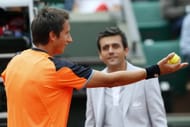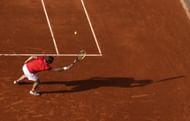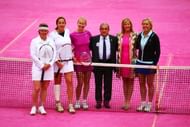Over the last fortnight, our senses have been bombarded with an overload of scenes, sounds and experiences from Paris. I am yet to recover from the hours of deep-red clay hitting my eyes, the sound of rhythmic grunts and screeches interspersed with monotonic deliveries of ‘Egalite’, the multitude of characters with racquets in hand and dreams in heart who flitted across my television set, some more often than others.
But I know that all this will soon pass into the dull recesses of my memory, simplistically summarised as one more title run by Rafa and Serena, one more glorious addition to the Rafa-Novak rivalry, one more perfect French Open spring. And all I will have left with me are a few random, scattered scenes which will remain etched in my mind. The particular reason for them being there is hard to fathom. They are not necessarily the most critical moments of the fortnight, not the most exciting, not even the most relevant. But in the days ahead, these snapshots will nevertheless mould my recollections of this year’s tournament, fashion my personal opinions on the dynamics within the game, stay with me longer than most. My freeze frames from the French Open 2013.
Gael Monfils plays a stretch volley winner against Thomas Berdych in the first round, turns to the crowd behind him and gently raises both his arms as the conductor of an orchestra might. The crowd responds as one, with deafening, lusty cheers.
Some players like to perform in a vacuum, some are able to turn on a crowd in their favour when they need to, and then, there is Gael Monfils. He never plays a tennis match without getting the audience involved, and in turn feeds off their energy to take his play to the next level. He did more of the same in his home Slam, playing some exhilarating tennis, and creating the biggest upset and loudest buzz of the first week. And he did all of this with a slightly more muted approach to the game than is customary. I gladly went along on the whirlwind ride across three exciting rounds, till he met defeat, quite predictably, in a deflated and completely spent state.
Tommy Robredo collapses into the welcome shade of his chair after beating Nicolas Almagro in the fourth round. He struggles to bite into an energy bar while accepting congratulations from an on-court official and choking back the emotions welling up from inside.
Robredo, proud member of the Over-30 Renaissance Club, had just done the unbelievable. He had won his third consecutive 5-set match after losing the first two sets, the first man in 86 years to do so in a Grand Slam tournament. The magnitude of his feat was just beginning to seep in. Coming at this stage of his career, no one could grudge him a few tears at that moment.
Sergiy Stakhovsky walks over to his chair, whips out a mobile phone, and proceeds to photograph a ball mark close to the lines, as dispassionately as a forensics expert at a crime scene.
This summed up the French Open for me, from an officiating perspective. From disgraceful howlers to too-close-to-call marks, from vigorous pleas for removing particular linesmen to impassioned debates on a ruling’s validity, the tournament had it all. The performances of the linesmen were consistently sub-par throughout, and only served to bring the Hawkeye clay debate firmly into the spotlight. For his personal contribution, Stakhovsky was fined $2000.
Serena Williams accepts her trophy with a speech in French. Halfway through, she turns to her family and support staff, and acknowledges them in her monologue. As the French crowd cheers, a confused Oracene Williams gestures a hilarious ‘Huh?’ at Serena.
Serena Williams won the title as she had always threatened to, and proceeded to give an acceptance speech entirely in French as she had always threatened to. She has a home in Paris and had been diligently learning the language, and you could see that by speaking to the crowd in their tongue, she was intent on proving a point to herself. As she brazened her way through the speech, I could feel the same aspect of her personality coming through as when she winds up on a ferocious forehand with the pressure on her in a rally. The Williams streak consists of an unshakeable, to the extent of unnerving, belief that she can achieve absolutely whatever she puts her mind to.
Richard Gasquet sends a backhand crosscourt return directed at an impossible angle across the lengthening shadows of Court Suzanne Lenglen. It seems for all accounts to be a winner till Stan Wawrinka hustles around to it, and sends a backhand down-the-line scorcher, leaving Gasquet stranded.
This wasn’t as much about the savage beauty of the particular rally, as it was about the entire series of enthralling exchanges from two stroke-making geniuses, fighting tooth-and-nail. For that brief period in the fourth set, the level of play reached ridiculously high levels, with both players going for broke on every single shot they played, and almost all of them coming off as well. It didn’t hurt that the primary weapon of choice for both of them was the delightful single-handed backhand.
Rafael Nadal watches from the baseline as Novak Djokovic, carried forward by his own momentum, stumbles into the net. Nadal spontaneously makes animated gestures to the chair umpire with pursed lips and pointed hand, in the air of a schoolboy bringing the misdeeds of his class rival to the attention of their teacher.
We could ponder forever on the intangible qualities of Nadal that draw us to him, but I believe a key ingredient is the emotional transparency, bordering on innocence, that he displays during battle. This gets reflected in his fist-pumping ‘Vamos!’ after an improbable winner, the agonised distortions of his face as he glances at his Uncle Toni after a bad miss, and the eager gesticulations at the chair umpire to make him take note of an issue that he is, no doubt, already aware of. Nadal bares his soul out there on a tennis court, he unabashedly gives it his all, and we love him for that.
A bevy of former WTA professionals are lined up in the center of Court Philippe Chatrier, with scenes from the original Battle of the Sexes playing on the giant screen behind them in the stands.
In celebration of the WTA’s 40th year of existence, there was a brief ceremony on Court Philippe Chatrier with a host of former female players, many of them French, appearing on centre court. Seeing faces from a period recently gone by, and hearing names I didn’t remember I had already forgotten – Sandrine Testud, Nathalie Tauziat – gave me a warm feeling of recognition. This was compounded by the unusual sight of people we are used to seeing with braided hair, tennis skirts and white sneakers suddenly burst upon us with flowing locks, smart casuals and high heels, but looking as toned as ever. As the Amazonian group turned on the smiles for the cameras, the WTA’s tagline seemed to make more sense than ever – Strong is Beautiful.
Sara Errani watches from a corner behind the baseline as Serena Williams pummels another forehand into the open court. The TV camera zooms in on Errani, as she widens her clear blue eyes and draws out a long, heavy breath.
It was hard not to feel sorry for Errani as her semi-final against the World No. 1 wore on. The result was never in much doubt right from the start, and it only got progressively worse. But what can you actually do in such a situation, when you know your opponent is operating on a level you have no hope of access to? You do what Errani did – pump yourself up by hopping proactively while returning serve, put every muscle and strategic nous you have into each shot you hit, run around the baseline like crazy, and then when you watch the inevitable thunderbolt whiz by you, you widen your eyes, exhale, and repeat the drill.
What is the foot injury that has troubled Rafael Nadal over the years? Check here



